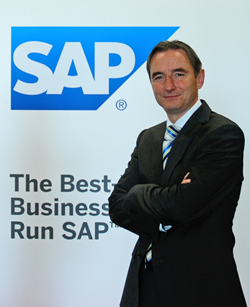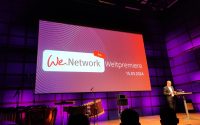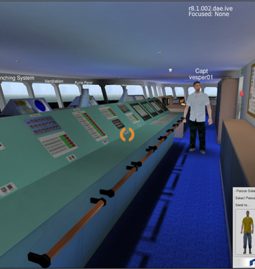
Happy birthday SAP! Even after 40 years of its existence, the software vendor shows no signs of becoming either a young- or oldtimer. Quite the contrary, a new campaign has been launched to come closer to the end-user. A discussion with Thomas Ohnemus, Senior Marketing Manager Manufacturing and PLM Affairs with SAP, about branding and a new integrated visualization solution.
Mr Ohnemus, your company has started a new branding campaign addressing what I would call “the dark side of IT” because it deals with emotions. In which way is your company perceived in the different target groups?
Over the last forty years, SAP has undergone a remarkable evolution: it has long grown out of the back office domain. It has got an excellent reputation as an IT solution provider in finance, human resources, and over the last 20 to 30 years in enterprise resource management. SAP is the worldwide leader in the ERP market. There we have a strong footprint and I am not wrong in saying that everybody knows SAP even if they don’t all use SAP applications. Coming from that point of view, we have similar reputations in other areas, like in the SCM or CRM markets. Our customers regard SAP as their backbone, and use it to execute standard processes around purchasing, finance, manufacturing, and so on. Of course, in the past we didn‘t enjoy a great reputation for flexibility, dynamic adaptation or intuitive user interfaces. But this is a historical point of view.
Let‘s come to engineers and PLM. Which attitude do they take to SAP?
In the research and development departments, the perception of SAP has a different history. When designers and engineers were moving from drawing boards to 2D and later to 3D CAD systems, they were confronted with applications of the very early phases of computerization to support their daily business. It was the beginning of visual representations of design intents and of data representation e.g. expressed in a bill of materials. And their requirements for any kind of user interface were and still are very high.
What were the reasons for these high requirements?
Well, they felt that they were different, let‘s say the creative guys in the company. In Human Resources or in Purchasing, you can find well established standard processes but not in engineering. They always insist on having individual organized processes and workflows.
Is that the reason why engineers don’t really like SAP?
This doesn’t necessarily mean that engineers don’t like SAP. They use their CAD system and were like spectators watching the rest of the company using SAP to support all the other business processes. You should know, in former times, there was hardly data exchange between the engineering departments and other departments.But over time, the tide has turned. Engineers must now meet requirements that go beyond CAD. They introduced the first PDM applications, because they have to manage complex data sets e.g. in collaboration scenarios, or because the product description has become more sophisticated. But the strong demand for flexibility and user friendliness remained for the supporting systems. That’s the reason why in the early days every PDM installation was highly adapted to customer’s ideas. If you put these requirements into the context of ERP applications with their standard interfaces and standard processes, quite obviously engineers asked: Why should we use SAP applications?
On the other hand, SAP claims to be the inventor of PLM, meaning your company is also active in engineering-driven domains – for more than fifteen years.…
Right, since the mid of the 1990s. We began our PLM activities as a spin-off of our ERP business. But if you look at the last releases 7.0 and 7.1 of SAP PLM, we have adopted engineers’ requirements and we have pushed our user interface towards state of the art techniques. Now the user interface is much easier to customize and to adapt to customer needs. And by the way, there was a good reason for its inflexibility in the past: If you changed something in the PLM processes in an uncontrolled manner, then owing to our close link to ERP it would have a great impact on business processes, meaning you might run into the danger of losing control of your whole business.
So, what you mean is, since the SAP approach was always to closely connect ERP and PLM processes, PLM customization has to be considered very carefully. In the other PLM offerings, where just a weak coupling to ERP is realized, a far-reaching customization on the PLM side is much easier because of its much more limited influence on the business world.
Absolutely right! To some extent we have consciously chosen a PLM offering reduced flexibility: Adding something to the master data of the product definition is very easy but you have to take a great deal of care if manufacturing or procurement processes supported by ERP or SCM systems are involved. Nevertheless over the time, SAP has changed dramatically, too: in terms of the user interface and in terms of extended offerings for customization. Since we have always been open, integration to other IT systems has never been an issue. And, if you look at the engineers’ daily work, it has also changed. They have learnt to accept that they cannot work any longer in an isolated silo like they used to do. Today, all the organizational units cooperate much more closely together than in the past.
I’ve got it. Time is on your side. But what then is the real reason your company has launched the branding campaign?
‘Humanize the brand’ is something that goes beyond PLM. Since the last, let’s say five to ten years, SAP has worked very hard on worldwide brand awareness. In 2005, we ranked at around 90th position in the world’s best known brands, by the end of 2011, SAP had got a branding status of 24.
Amazing!
Yes, indeed. We are now better known than companies like Nike. This is unbelievably high value for our company. But this is just the beginning of the story. As you know, the whole world is changing owing to the influence of the internet, meaning that the next generation of people using IT will have very different expectations of how IT should work.
What will be the consequences for SAP?We have to come much closer to the end-consumer and to the end-user of our applications. So, moving from the enterprise business software vendor that we really are – and keep in mind: we are driving two third of all business processes around the world, we want to win end-consumers as new stakeholders. That is what ‘Humanize the brand’ is about: making clear that SAP helps them to drive their daily businesses in a unique way.
Thank you for your comments!
Interview: BERNHARD D. VALNION







